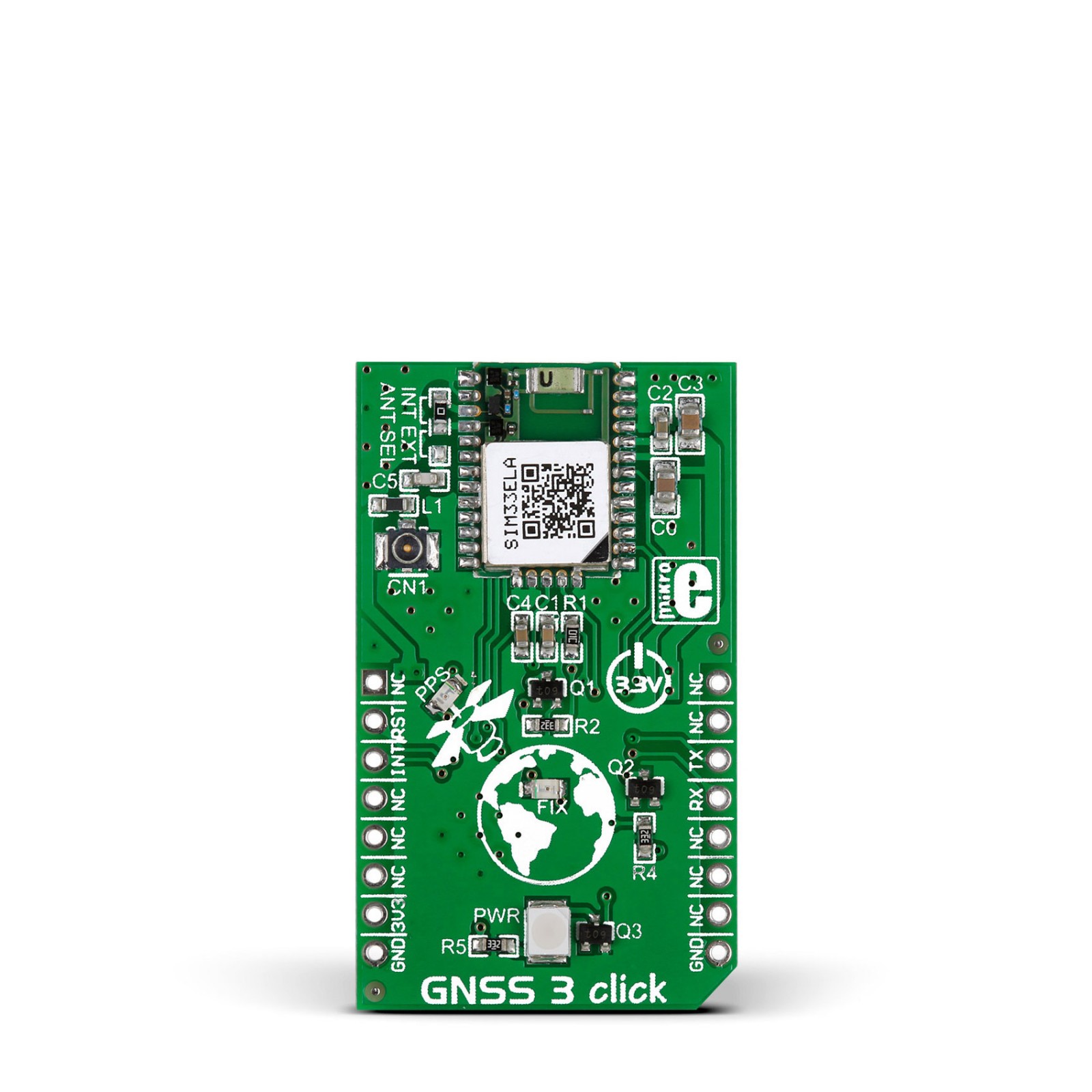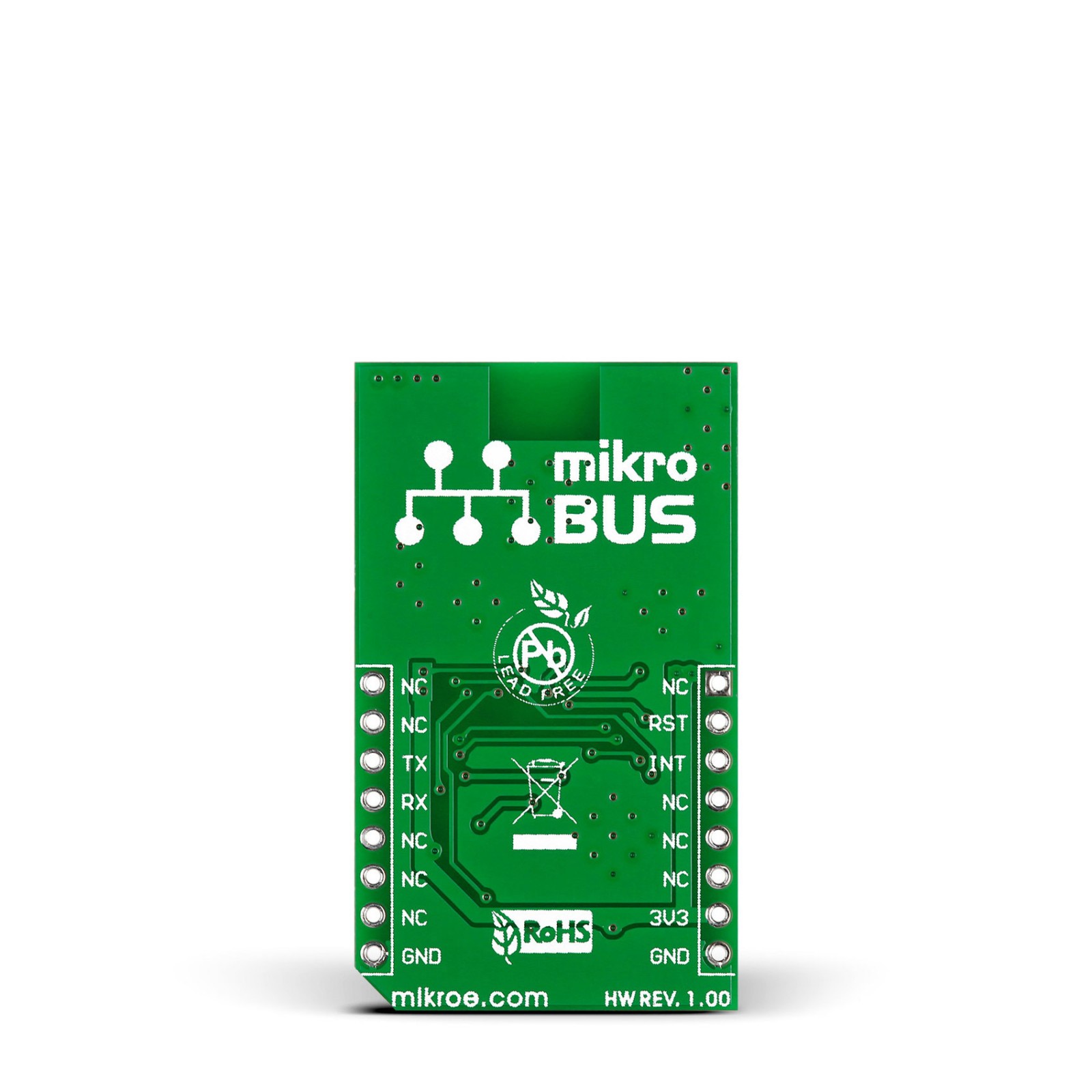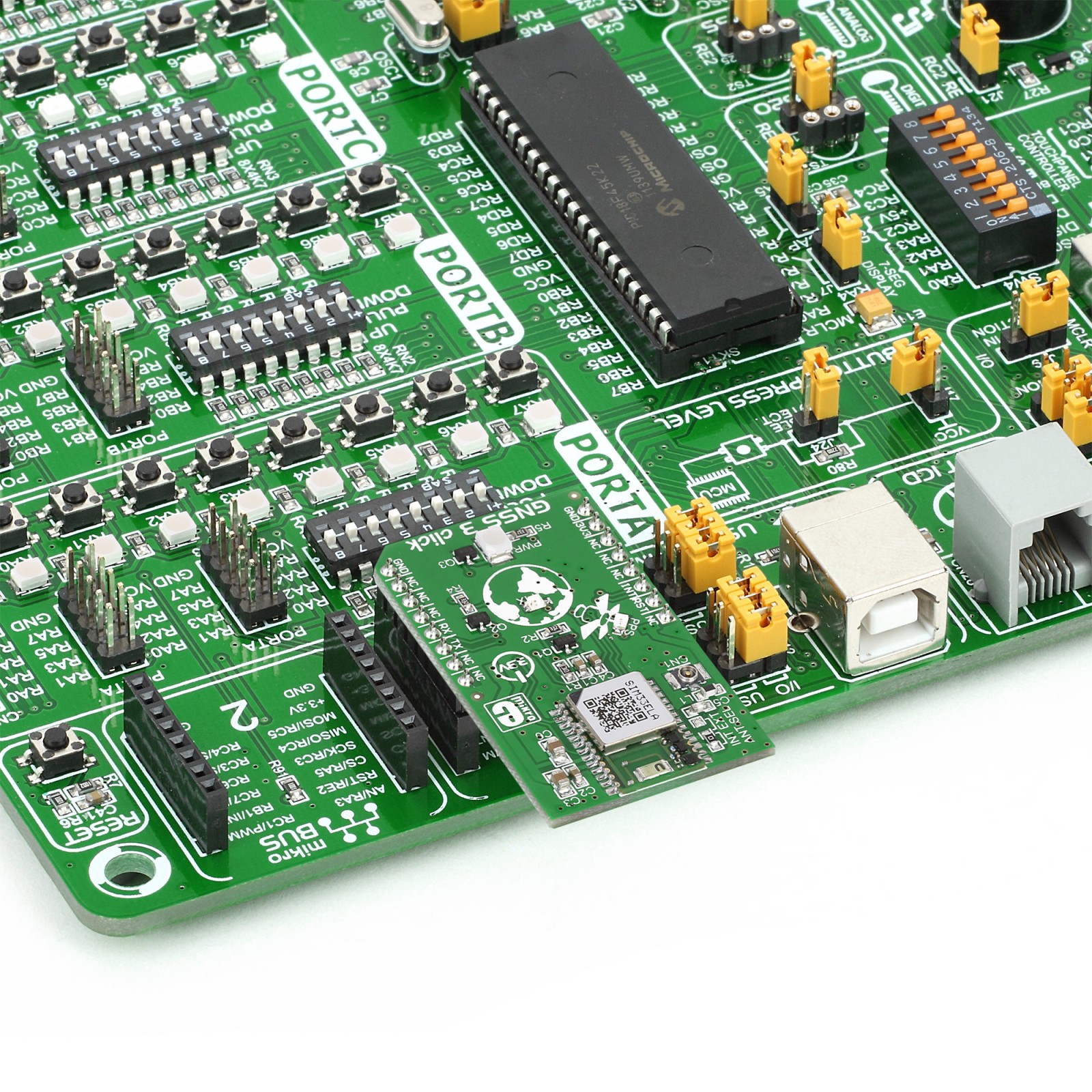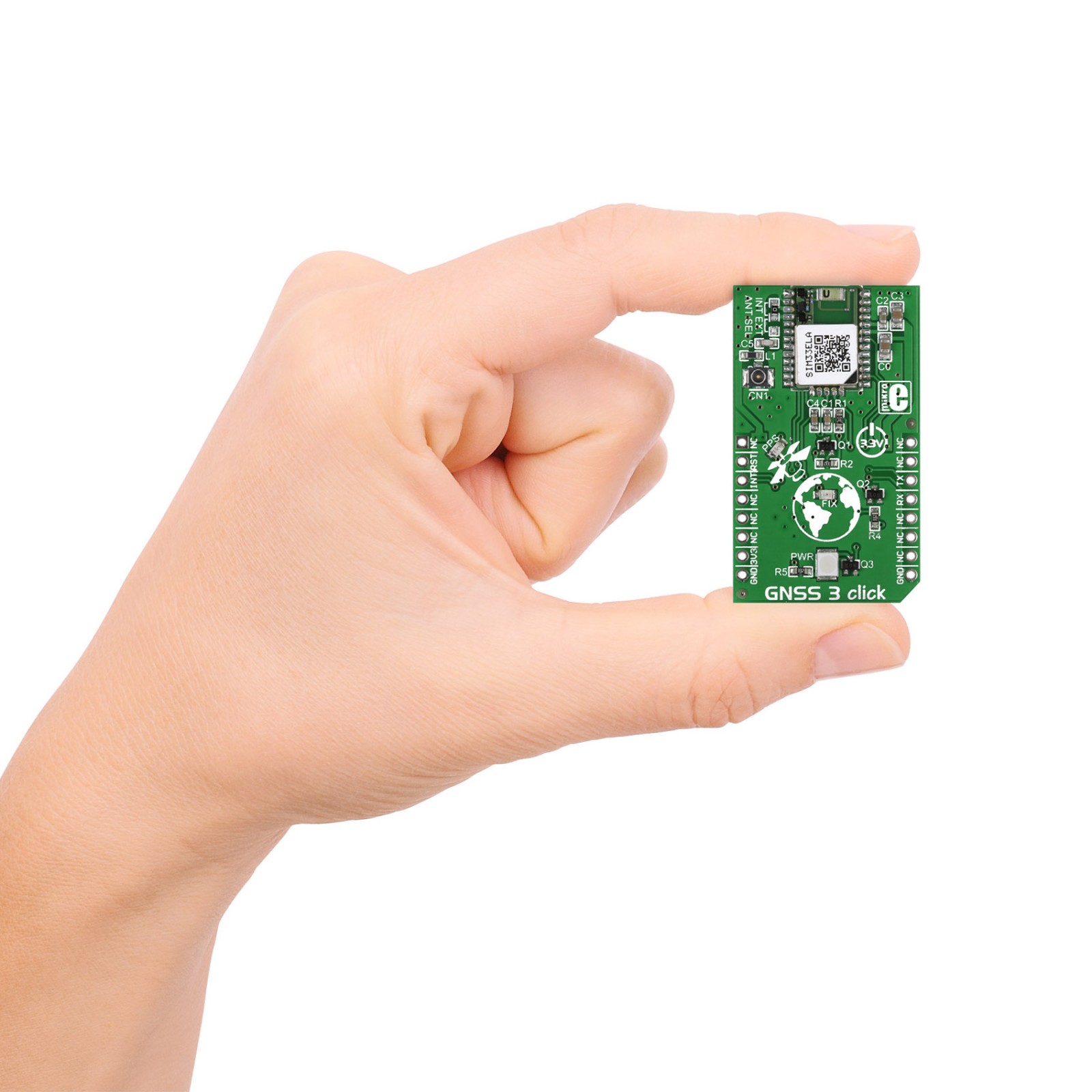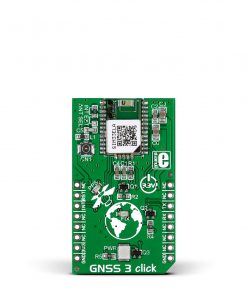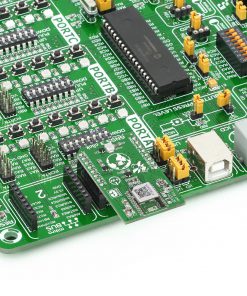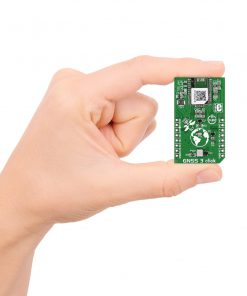Subtotal: R370.00
GNSS 3 Click
R875.00 R510.00 ex. VAT
GNSS 3 Click is a compact add-on board that provides fast positioning capability. This board features a SIM33ELA, a standalone GNSS module with an integrated antenna from a SIMCom. The SIM33ELA is a concurrent GNSS receiver with multiple GNSS systems, providing simultaneous GPS, GLONASS, Galileo, SBAS, A-GPS, and QZSS open-service L1 reception capability. Combining advanced software features like EASY self-generated prediction, EPO/HotStill orbit prediction, AlwaysLocate, Active Interface Cancellation (AIC), and more, this module makes the excellent choice for acquisition and tracking in automotive, consumer, and industrial applications.
GNSS 3 Click is supported by a mikroSDK compliant library, which includes functions that simplify software development. This Click board™ comes as a fully tested product, ready to be used on a system equipped with the mikroBUS™ socket.
Stock: 1 available immediately.
How does it work?
GNSS 3 Click is based on the SIM33ELA module, a standalone or A-GPS receiver with a built-in chip antenna from a SIMCom. The SIM33ELA supports only the L1 band with 33 tracking and 99 acquisition channels. The module provides complete signal processing from antenna input to host port in either NMEA messages with the maximum update rate of 10Hz. The module is an ultra-low tracking power consumption device with a high sensitivity of -165dBm while tracking and -147dBm in acquisition mode with fast re-acquisition time. The greater number of visible satellites increases positioning accuracy (<2.5m CEP) and decreases acquisition time (<1.5s TTFF with a warm start). GNSS 3 Click supports anti-jamming, better positioning under weak signal conditions with onboard LNA, and 12 multi-tone active interference cancellers.
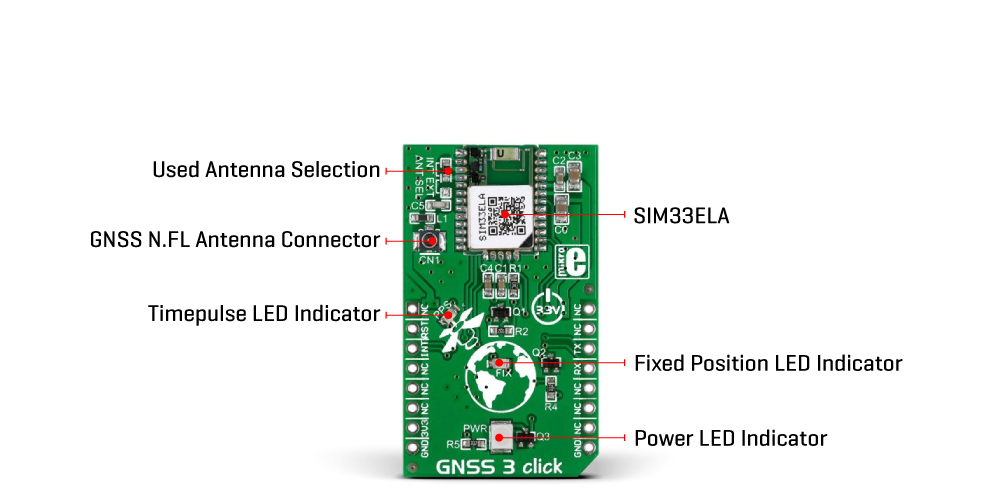
The SIM33ELA supports EPO (Extended Prediction Orbit) data service that can predict 7/14/31-day orbit to customers, with occasional downloads from the EPO server. The information like ephemeris, almanac, rough last position and time, the satellite status, and optional time synchronization will reduce TTFF and can be uploaded to the SIM33ELA module by the host side. EASY (Embedded Assistant System) mode predicts satellite navigation messages from the received ephemeris. The module also supports DGPS SBAS (Satellite Based Augmentation System) and RTCM, where only one mode can be used at a time. The SBAS depends on the user’s continent.
The SIM33ELA uses the UART interface with commonly used UART RX and TX pins as its default communication protocol for communication with the host microcontroller. It operates at 115200bps by default configuration to transmit and exchange data. In addition, this Click board™ features other functions accessible through mikroBUS™ signals, such as Reset (RST) for resetting the device and INT pin that could control the module coming into or waking up from Sleep mode.
In addition to the possibility of using the built-in chip antenna, this Click board™ can also use an external active antenna (https://www.mikroe.com/accessories/antennas) offered by Mikroe, thanks to the onboard n.FL connector and ANT SEL solder jumper set to INT or EXT position. In addition to precise positioning, the GNSS 3 Click also has an accurate timing signal indicated via a red LED indicator marked as PPS, the successful positioning indicated by a yellow LED indicator marked as FIX, and the green PWR LED, which acts as a wake-up indicator.
This Click board™ can only be operated from a 3.3V logic voltage level. Therefore, the board must perform appropriate logic voltage conversion before using MCUs with different logic levels. However, the Click board™ comes equipped with a library containing functions and an example code that can be used as a reference for further development.
Specifications
Type
GPS/GNSS
Applications
Can be used for acquisition and tracking in automotive, consumer, and industrial applications
On-board modules
SIM33ELA – standalone or A-GPS receiver with built-in chip antenna from a SIMCom
Key Features
Multi-GNSS engine for GPS, GLONASS, Galileo, SBAS, A-GPS, and QZSS, supports L1 GNSS band, built-in LNA for better sensitivity, low power consumption, high performance, and more
Interface
GPIO,UART
Feature
No ClickID
Compatibility
mikroBUS™
Click board size
L (57.15 x 25.4 mm)
Input Voltage
3.3V
Pinout diagram
This table shows how the pinout on GNSS3 Click corresponds to the pinout on the mikroBUS™ socket (the latter shown in the two middle columns).
Onboard settings and indicators
| Label | Name | Default | Description |
|---|---|---|---|
| LD1 | FIX | – | Successful Positioning LED Indicator |
| LD2 | PPS | – | Pulse Per Second LED Indicator |
| LD3 | PWR | – | Wake Up LED Indicator |
| – | ANT SEL | Upper | Antenna Selection INT/EXT: Upper position INT, Lower position EXT |
GNSS3 Click electrical specifications
| Description | Min | Typ | Max | Unit |
|---|---|---|---|---|
| Supply Voltage | – | 3.3 | – | V |
| Maximum Altitude | – | 18 | – | km |
| Acquisition Sensitivity | – | -147 | – | dBm |
| Tracking Sensitivity | – | -165 | – | dBm |
| TTF Cold Start | – | 28 | – | sec |
Software Support
We provide a library for the GNSS3 Click as well as a demo application (example), developed using Mikroe compilers. The demo can run on all the main Mikroe development boards.
Package can be downloaded/installed directly from NECTO Studio Package Manager (recommended), downloaded from our LibStock™ or found on Mikroe github account.
Library Description
This library contains API for GNSS3 Click driver.
Key functions
-
GNSS 3 parse GNGGA function.
-
Generic read function.
-
Wake-up module.
Example Description
This example demonstrates the use of GNSS 3 click by reading and displaying the GPS coordinates.
void application_task ( void )
{
gnss3_process( &gnss3 );
if ( app_buf_len > ( sizeof ( ( char * ) GNSS3_RSP_GNGGA ) + GNSS3_GNGGA_ELEMENT_SIZE ) )
{
gnss3_parser_application( app_buf );
}
}
The full application code, and ready to use projects can be installed directly from NECTO Studio Package Manager (recommended), downloaded from our LibStock™ or found on Mikroe github account.
Other Mikroe Libraries used in the example:
- MikroSDK.Board
- MikroSDK.Log
- Click.Gnss3
Additional notes and informations
Depending on the development board you are using, you may need USB UART click, USB UART 2 Click or RS232 Click to connect to your PC, for development systems with no UART to USB interface available on the board. UART terminal is available in all Mikroe compilers.
mikroSDK
This Click board™ is supported with mikroSDK – Mikroe Software Development Kit. To ensure proper operation of mikroSDK compliant Click board™ demo applications, mikroSDK should be downloaded from the LibStock and installed for the compiler you are using.
For more information about mikroSDK, visit the official page.
Resources
Downloads
| Weight | 26 g |
|---|---|
| Brand | MikroElektronika |

 DIGI POT Click
DIGI POT Click 